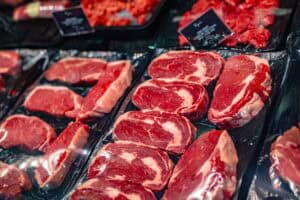Expert shares insights into factors behind soaring global food prices.

Food prices are at an all-time high, leaving most South Africans with emptier pockets at the end of each grocery shopping trip.
But, what’s the reason behind the pocket-pinching prices?
Uncovering the mysteries behind the soaring cost of food made it onto the Competition Commission’s itinerary on Thursday during the 17th Annual Competition Law, Economics and Policy Conference held in Fourways, Johannesburg.
During his opening remarks, Chief Economist at the Competition Commission, James Hodge, said food inflation was at record-high levels, with poor consumers bearing the brunt.
ALSO READ: New plan to improve food security
Hodge said that food prices had increased by approximately 34% since the onset of the Covid-19 pandemic, noting that the price of vegetables, oils and fats, bread and dairy had recently increased drastically.
He pointed out that most poor households spent 40% of their budget on food.
Climate change and the Russia-Ukraine war have worsened the harsh economic effects of Covid-19, plaguing the global market in a post-pandemic world.
Input costs vs food prices
Input costs vs food prices
Agricultural Business Chamber Chief Economist Wandile Sihlobo said there were misconceptions about the relationship between input costs and food prices.
“The only way a farmer can influence the price of a commodity is through limiting how much they produce,” he said.
Sihlobo said although SA imports a large percentage of agricultural input, there’s no direct relationship between input and commodity prices.
ALSO READ: Load shedding threatening food security in SA
“We import almost all of our inputs – 80% of fertiliser and 98% of the agro-chemicals, so whatever happens to the prices of those commodities, the farmer has to take those on,” he said.
“And they have to cover themselves by making sure they get better yields, and they position their trading in a better time to be able to cover those costs,” he explained.
According to Sihlobo, three major factors contributed to the increase in global food prices.
- China bought a lot of grains in the market: it bought a lot of maize and soybeans just before the Covid-19 pandemic, which affected global commodity prices.
- Drought in South America which lasted for four years: 50% of soybeans and 15% of maize are imported from Argentina and Brazil. Supply constraints caused an increase in global prices.
- Russia-Ukraine War – which has affected global supply chains.
Cushioning against global shocks
Senior Researcher at the Centre for Competition, Regulation and Economic Development (CCRED) at the University of Johannesburg, Prof. Reena Das Nair weighed in.
She said developing food markets that could replace import of inputs and processed foods could cushion the continent against global economic shocks.
“If we create more inclusive regional value chains in food, that can contribute to the resilience of food value chains in the long run,” she explained.
Nair urged industry players to consider ways to develop value chains to turn primary products into value-added food products within the region to replace some imports, further explaining that the process would require coordinated policies and efforts.
Competition & transport
Nair said competitive markets were essential to creating strong value chains.
“Without competitive inputs, other players [such as] SMEs (Small Medium Enterprises) – are not going to be able to produce at a margin that’s sustainable,” she said.
On the need for a seamless logistics infrastructure, Nair said market players must think of ways to reduce costs in the various value chains, which include setting up efficient transport networks among regions.
“If there are competition issues in cross-border transport, then we’re going to have a higher cost of moving products at different levels of the value chain – from one country to another,” she said.
“We need to deal with competition issues in transport and logistics,” she added.
When it comes to mitigating the impact of climate change on agriculture, Nair said SA’s water crisis hindered the production of certain crops.
“We cannot continue to grow certain crops in SA [due to water scarcity],” she said.
ALSO READ: Africa needs electricity for its food security
Strong alternative routes
Nair said large supermarkets played a major role in food supply chain.
“When talking about food markets, we can’t [ignore] the large players present, both at the processing level, as well as at the retail level,” she said.
Pointing the impact of anti-competitive behavior by retailers on the value chain, Nair said: “often, it’s the large supermarket chains that are the gatekeepers between suppliers and consumers.”
She further said large food retailers dominated markets in the Southern African region, highlighting the need to foster co-operative relationships between supermarket chains and SMEs.
The economist proposed simplifying the way suppliers get products to end consumers as a solution.
According to Nair, strengthening alternative routes to markets such as informal retailers and fresh produce markets would give suppliers more channels to get their products to consumers – not just through large retailers.
“We don’t see much diversity in terms of alternative routes to markets,” Nair said.
She also praised the Competition Commission for eliminating exclusive lease agreements in shopping malls – which she said would enable independent retailers to access lucrative business areas.
ALSO READ: Experts predict greater food security threat in Africa over the next two decades






